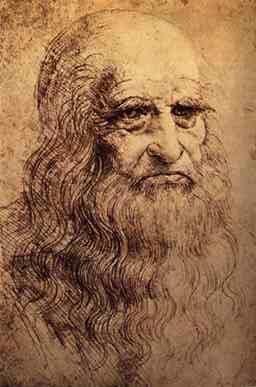Have you seen the Mona Lisa or The Last Supper?
Leonardo da Vinci is considered one of the greatest painters of all time because of these magnificent works. What many people forget is that Leonardo da Vinci was also a great scientist. He was born on April 15, 1452 in Florence and died on May 2, 1519 in France. It is said that he embodies the true “Renaissance man” because he was very curious and he invented ways in order to satisfy that curiosity. Leonardo has so many achievements that he has been called the “Perfect Man,” the “Perfect Artist” and the “Universal Genius.”

What happened during Leonardo’s childhood?
Many people do not know that Leonardo’s parents were not married. This was the reason why he was called an illegitimate child. His father was a wealthy lawyer named Piero da Vinci while his mother was a poor peasant named Caterina. It is said that he stayed with his mother until he was five years old. Later on, he went to stay with his father. He did not go to school but was taught at home on the subjects of Latin, Mathematics and Geometry.
What happened when Leonardo was a teenager?
When Leonardo turned 14 years old, he became an apprentice to an artist named Andrea di Cione, more famously known as Verrochio. A person is called an “apprentice” if he works under a “master” to gain certain skills. As an apprentice, Leonardo learned different skills including chemistry, plaster casting, mechanics, carpentry, drawing, painting, modelling and sculpting. In 1478, he finally left Verrochio in order to establish his own professional career as a painter.
What happened in Leonardo’s professional life?
Leonardo was commissioned by several powerful figures in Italy. He worked for the ruling family of the Medicis, particularly for Lorenzo de Medici. It is said that Leonardo once created a silver lyre shaped like a horse head. Lorenzo de Medici sent Leonardo to bear this lyre as a gift to Ludovico il Moro, the Duke of Milan, in order to have peace between Florence and Milan. While he was in Milan, he painted the famous paintings Virgin of the Rocks and The Last Supper. The Duke of Milan then employed Leonardo for different projects. He is said to have acted both as a painter and an engineer during this time. His work included preparing designs and floats for special occasions, designing the Milan Cathedral and preparing an equestrian (horse) monument dedicated to the great Milan leader Francesco Sforza. However, he was only able to create a clay model.
What were Leonardo’s scientific achievements?
Leonardo was not only interested in the arts. He was also a very observant and creative scientist. During the Renaissance, this interest in both the arts and the sciences was encouraged.
- Geometry. Leonardo became interested in geometry after reading books in architecture and perspectives in painting. He was the illustrator for the mathematics book “Divina Proportione” by the mathematician Luca Pacioli.
- Biology and Anatomy. Leonardo’s interest in natural philosophy meant he explored biology and anatomy. He often wrote his observations in journals. One thing unique about Leonardo is that he wrote from right to left, which meant that his notes are best read when reflected by a mirror. Some people have suggested that he wanted to keep his notes secret but others believed that it was easier for him to write this way because he was left-handed. He drew the Vitruvian Man or the Proportions of Man, which is considered to be an anatomically correct representation of the human body. You might have seen replicas of this Vitruvian Man because it is now used as a symbol of medical professionals or establishments. Another famous anatomical illustration of Leonardo was a fetus in the womb and its heart. You might ask how Leonardo could have drawn these things without models. Actually, he did have actual models. Because he was a famous artist, the Hospital of Santa Maria Nuova, located in Florence, gave him permission to study human corpses. From these studies, he was able to draw the human skeleton, muscles, heart, circulatory system and internal organs. Because he wrote observations regarding how muscles and bones move, he is said to have been the first person that explored biomechanics, an important science, which is now being applied to prosthetics and robots. He also dissected animals such as cows, monkeys, frogs, birds and horses and compared their anatomical structures with those of humans.
- **Engineering.**Leonardo was a very good engineer. As mentioned, he served under the Duke of Milan for this purpose. He also designed barricades to protect Venice from invaders. He designed pumps, tanks, mortar shells, crank mechanisms and steam cannons. Leonardo was greatly interested in birds. It is said that he bought birds in cages just to release them. Perhaps he did so because he wanted to design a machine that would fly. His observations on flight were recorded in a book called Codex on the Flight of Birds. In this book, it can be seen that Leonardo already had ideas on how to design a glider and a helicopter. Indeed, Leonardo da Vinci was an amazing visionary.
